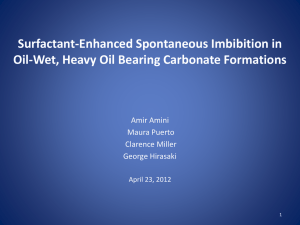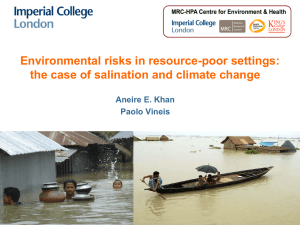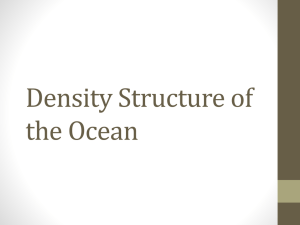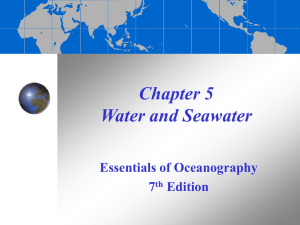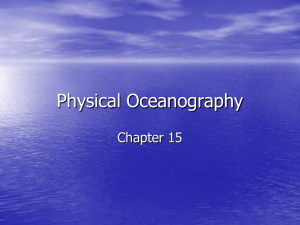Aparna
advertisement
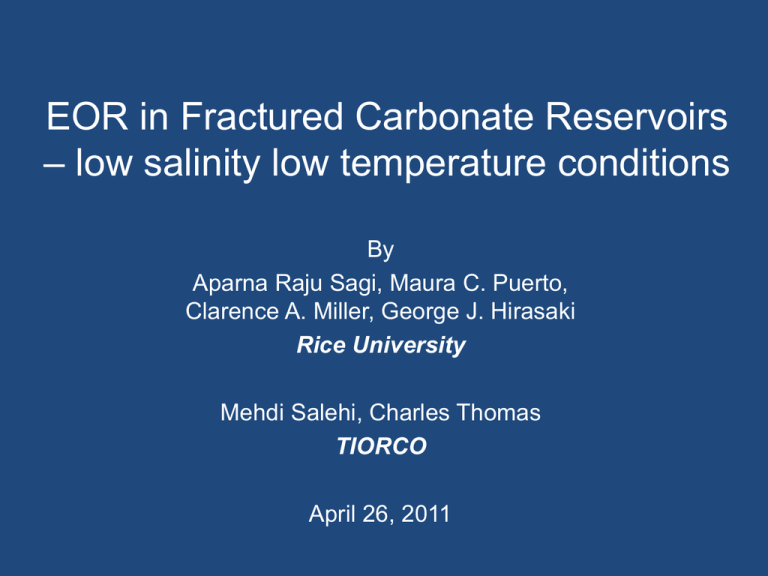
EOR in Fractured Carbonate Reservoirs – low salinity low temperature conditions By Aparna Raju Sagi, Maura C. Puerto, Clarence A. Miller, George J. Hirasaki Rice University Mehdi Salehi, Charles Thomas TIORCO April 26, 2011 Outline • EOR strategy for fractured reservoirs • Evaluation at room temperature (~25 °C) o o o o Phase behavior studies – surfactant selection Viscosity measurements Imbibition experiments Adsorption experiments • Evaluation at 30 °C and live oil o Phase behavior experiments o Imbibition experiements • Conclusions 2 EOR strategy 3 EOR strategy • Reservoir description o Fractures – high permeability paths o Oil wet – oil trapped in matrix by capillarity o Dolomite, low salinity, 30 °C • Recover oil from matrix spontaneous imbibition o IFT reduction • Surfactants o Wettability alteration • Surfactants • Alkali Ref: Hirasaki et. al, 2003 4 Current focus – IFT reduction – surfactant flood • Surfactant flood desirable characteristics o Low IFT (order of 10-2 mN/m) o Surfactant-oil-brine phase behavior stays underoptimum o Low adsorption on reservoir rock (chemical cost) o Avoid generation of viscous phases o Tolerance to divalent ions o Solubility in injection and reservoir brine o Easy separation of oil from produced emulsion 5 Phase behavior studies at ~ 25 °C 6 Procedure Seal open end 24 hr Oil Initial interface Brine + surfactant Parameter • Salinity • Surfactant blend ratio • Soap/surfactant ratio micro Varying parameter micro Pipette (bottom sealed) Winsor Winsor Winsor Type - I Type - III Type - II Optimal parameter 7 𝜎mo 𝜎mw middle Vo/Vs Vw/Vs upper Solubilization parameter lower IFT, mN/m Phase behavior, IFT, solubilization parameter Salinity, wt% NaCl Reed et al. 1977 8 Phase behavior • Purpose of phase behavior studies o Determine optimal salinity, Cø • transition from Winsor Type I to Winsor Type II o Calculate solubilization ratio, Vo/Vs and Vw/Vs o Detect viscous emulsions (undesirable) • Parameters o o o o o Salinity – 11,000 ppm (incl Ca, Mg) Surfactant type, Blend ratio (2 surfactants) Oil type – dead oil vs. live oil Water oil ratio (WOR) Surfactant concentration 9 1 1.1 1.2 1.3 1.4 1.5 1.6 1.7 1.8 1.9 Brine2 4wt% optimal salinity S13D Salinity scan (Multiples of Brine2) WOR ~ 1 Vo/Vs~ 10 at reservoir salinity optimal salinity 0.5wt% optimal salinity 0.25wt% 10 Viscosity studies at ~ 25 °C 11 Viscosities of phases – function of salinity 0.5 wt% S13D upper phase 16d Viscosities of phases as function of salinity for S13D 0.5 wt% middle section 16d reservoir salinity Viscosity (cP) Optimal salinity 1000 100 optimal salinity lower phase 16d 0.4 cm 0.3 cm 0.1 cm Oil Oil 10 1 0.8 1 1.2 1.4 salinity (multiples of Brine 2) 0.84 0.94 1.05 1.15 1.26 1.36 1.47 Multiples of Brine 2 12 Imbibition studies at ~ 25 °C 13 Imbibition results – S13D reservoir cores (1”) 80 S13D 0.5wt% 126md 70 Recovery (% OOIP) 60 50 40 S13D 0.25wt% 151md 30 20 10 0 0 20 40 60 80 100 Time (days) Mehdi Salehi, TIORCO 14 S13D candidate for EOR o under-optimum at reservoir salinity o stays under-optimum upon dilution o Vo/Vs~10 (at 4wt% surfactant concentration) indicative of low IFT o No high viscosity phases at reservoir salinity o ~ 70% recovery in imbibition tests 15 Adsorption studies at ~ 25 °C 16 Dynamic adsorption – procedure • Sand pack o Limestone sand ~ 20-40 mesh o Washed to remove fines & dried in oven • Core holder o Core cleaned with Toluene, THF, Chloroform, methanol o Core holder with 400 – 800psi overburden pressure • Vacuum saturation (~ -27 to -29 in Hg) o measure pore volume • Permeability measurement 17 Dynamic adsorption - setup Syringe pump/ ISCO pump Core holder/ Sand pack Bromide electrode Bromide concentration reading Pressure monitoring Pressure transducer Sample collection 18 Limestone sandpack ~ 102D • Injection solution: Brine 2 with 1000ppm Br - + 0.5wt% S13D • Flow rate: 12.24ml/h • Pore volume: 72 ml, Time for 1PV ~ 6hrs 1PV 2PV • 1PV = .38 ft3/ft2 • Lag ~ 0.14 PV • Adsorption 0.26 mg/g sand 0.12 mg/g reservoir rock 19 Reservoir core – 6mD • Injection solution: Brine 2 with 1000ppm Br - + 0.5wt% S13D • Flow rate: 2ml/h • Pore volume: ~12 ml, Time for 1PV ~ 6hrs 3PV 4PV day 3 2PV day 1 1PV • 1PV = .035 ft3/ft2 • Effective pore size = 26.8𝜇m • Lag ~ 0.54PV to 1.25PV • Adsorption 0.12 mg/g rock to 0.28 mg/g rock 20 Reservoir core – 6mD plugging 1PV 9 2PV 3PV 4PV 5PV Expected pressure drop @ 15ml/hr 8 Absence of surfactant pressure (psi) 7 6 5 Presence of surfactant – dyn ads exp 4 day 1 3 2 day 3 – no data day 11 Expected pressure drop @ 2ml/hr 1 0 0 10 20 30 40 volume produced (ml) 50 60 21 HPLC analysis of effluent 1PV 1PV 2PV 2PV 3PV 3PV 4PV 4PV HPLC sample day 3 day 1 diff in area ~ 21 % By Yu Bian 22 Reservoir core – 15mD • 2 micron filter @ inlet – pressure monitored • Injection solution: Brine 2 with 1000ppm Br - + 0.5wt% S13D • Flow rate: 1ml/h, Pore volume: ~30 ml, Time for 1PV ~ 1.25 days 1PV 2PV 3PV 4PV 5PV HPLC sample Bromide Surfactant • 1PV = .103 ft3/ft2 • Effective pore size = 11.8𝜇m • Lag ~ 0.67PV • Adsorption 0.29 mg/g rock 16 15 14 10 9 8 7 6 3 4 2 day1 Pressure 23 HPLC analysis of effluent diff in area ~ 25 % By Yu Bian 24 Adsorption results comparison Experiment Material Equivalent adsorption on reservoir rock (mg/g) Residence time (hrs) Dynamic Limestone sand 0.12 6 Dynamic Dolomite core 6mD 0.12 – 0.28 6 - overnight Dynamic Dolomite core 15mD 0.29 30 Static (by Yu Bian) Dolomite powder 0.34 24 25 Phase behavior studies at ~ 30 °C 26 S13D phase behavior S13D 1wt% @ 25 °C S13D 1wt% @ 30 °C Type I microemulsion Type II microemulsion S13D 1wt% @ 30 °C with live oil (600 psi) Type II microemulsion 27 S13D/S13B blend scan 30°C Optimal blend Brine 2 salinity; 2 wt% aq; WOR = 1 10/0 S13D 9/1 8/2 7/3 6/4 5/5 4/6 S13D/S13B ratio 3/7 2/8 1/9 0/10 S13B 28 5 5 4 4 3 3 2 2 1 1 0 0 Phase behavior S13D/S13B blend With dead oil @ 30 °C % Cs S13D 10 9 S13B 0 1 8 2 7 3 6 4 Aqueous stability test of S13D/S13B blend 5 5 4 6 3 7 50 2 8 1 9 0 10 50 40 40 °C 30 30 20 20 10 10 0 S13D 10 9 S13B 0 1 0 8 2 7 3 6 4 5 5 4 6 3 7 2 8 1 9 0 10 29 S13D/S13B (70/30) – dead vs live crude @ 30 °C Dead oil – UNDER-OPTIMUM After mixing & settling for 1 day Live oil – OVER-OPTIMUM Before mixing After mixing & settling for 1 day 30 Imbibition studies at ~ 30 °C 31 Imbibition results –reservoir cores (1”) S13D 0.5wt% 126mD, 25 °C S13D/S13B 70/30 1wt% 575mD, 30 °C S13D 0.25wt% 151mD 25 °C S13D/S13B 60/40 1wt% 221mD, 30 °C Mehdi Salehi, TIORCO 32 Conclusions 33 Conclusions • Dynamic adsorption experiments (absence of oil) o Effluent surfactant concentration plateaus at ~80% injected concentration o Higher PO components are deficient in the effluent sample (in plateau region) o Increase in pressure drop with volume throughput • Sensitivity of phase behavior to temperature and oil (dead vs. live) • S13D/S13B 70/30 @ 30 °C performance poor compared to S13D @ 25 °C 34 Questions 35


